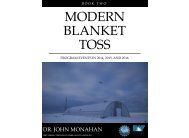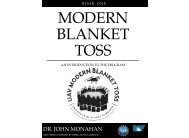Modern Blanket Toss: Findings and Observations
This book is the last in a series of three covering the National Science Foundation awarded Modern Blanket Toss project. In this book are the evaluation findings for each of the three years as well as observations from Modern Blanket Toss staff.
This book is the last in a series of three covering the National Science Foundation awarded Modern Blanket Toss project. In this book are the evaluation findings for each of the three years as well as observations from Modern Blanket Toss staff.
Create successful ePaper yourself
Turn your PDF publications into a flip-book with our unique Google optimized e-Paper software.
2016 FINDINGS<br />
Analysis: For each construct, we calculated<br />
a scale score for each respondent. The scale<br />
score is the average of the response to items<br />
included in the scale. For “Content<br />
Knowledge,” respondents rated their own<br />
knowledge from 1 (low level of knowledge)<br />
to 10 (high level of knowledge), so the scale<br />
score also has a range of 1 to 10. For the<br />
“Communication Skills” items, respondents<br />
chose “not comfortable at all” (equal to 1),<br />
“somewhat comfortable” (equal to 2),<br />
“moderately comfortable” (equal to 3), or<br />
“very comfortable” (equal to 4). The scale<br />
score is an average between 1 <strong>and</strong> 4. All other<br />
items asked respondents to “strongly disagree”<br />
(equal to 1), “disagree” (equal to 2),<br />
“agree” (equal to 3), or “strongly agree” (equal<br />
to 4), so those scales also range from 1 to 4<br />
with 4 as a more positive score. We used a paired samples t-test to test<br />
whether the mean scale scores were significantly different (P < 0.05) between<br />
an individual’s first survey <strong>and</strong> last survey.<br />
Sample: During the three year project there were 234 responses to the<br />
survey from 90 individual students. As the survey was designed to give pre/post<br />
information, only surveys from those students who completed both a pre <strong>and</strong> a<br />
post-survey were included. In all, 57 students completed the surveys at least two<br />
times; Chefornak had the greatest number of individuals complete the survey<br />
<strong>and</strong> Shishmaref had the least (Table 2).<br />
Table 2 Count, by school, of individual students who completed two or more surveys.<br />
School<br />
Total<br />
Individuals<br />
May<br />
2014<br />
July<br />
2014<br />
Sept<br />
2014<br />
April<br />
2015<br />
May<br />
2015<br />
Note: In total these students completed 199 valid surveys; some students completed the survey more than two times.<br />
2. Student Weekly Survey<br />
July<br />
2015<br />
Sept<br />
2015<br />
April<br />
2016<br />
May<br />
2016<br />
July<br />
2016 Total<br />
Bethel 11 7 7 5 7 3 2 7 7 2 2 49<br />
Chefornak 19 6 6 12 13 6 6 13 14 4 3 83<br />
Nikiski 13 2 2 4 8 0 0 10 5 1 0 32<br />
Seward 5 0 0 4 4 1 1 0 0 1 1 12<br />
Shishmaref 4 1 1 4 4 1 2 0 0 0 0 13<br />
Chevak <strong>and</strong> Saint<br />
Mary’s<br />
Table 3 Student weekly survey satisfaction scale Cronbach's alpha results<br />
Scale n Items Item Mean Min Max Range Variance Cronbach’s Alpha<br />
Satisfaction 205 10 3.16 2.74 3.43 0.693 0.047 0.81<br />
5 0 0 0 0 5 5 0 0 0 0 10<br />
Total 57 16 16 29 36 16 16 30 26 8 6 199<br />
The Student Weekly Survey was designed to measure, over the course of the<br />
summer program, changes in participating students’ 1) content knowledge <strong>and</strong><br />
science practices related <strong>Modern</strong> <strong>Blanket</strong> <strong>Toss</strong> content <strong>and</strong> 2) their satisfaction<br />
with the summer program activities, as well as to provide immediate feedback<br />
to course instructors. A copy of the survey is included in Appendix A.<br />
The survey included 10 Likert-scale items that we combined to make a<br />
satisfaction scale. To measure the reliability of the satisfaction scale, we calculated<br />
Cronbach's alpha coefficient for each scale using SPSS. The Cronbach's<br />
alpha for the satisfaction scale was 0.810; a Cronbach’s alpha that is<br />
greater than 0.7 is considered evidence that the items included<br />
measure an underlying construct (George <strong>and</strong> Mallery, 2003). Results<br />
of the reliability analysis are summarized in Table 3.<br />
39




